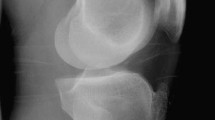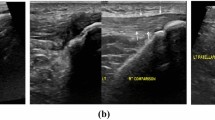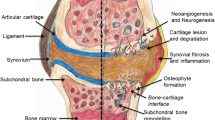Abstract
The origin of Achilles tendon insertional pain has not been clarified. Treatment is considered difficult, though tendon, bone, and bursae, alone or in combination, may all be the source of pain. Recently, neovascularisation in the area with tendon changes was shown to correlate with pain in patients with chronic mid-portion Achilles tendinosis. In a pilot study, sclerosing the neovessels outside the tendon cured the pain in the majority of patients. In this pilot-study, ultrasonography and colour Doppler was used for the investigation of eleven patients (nine men and two women, mean age 44 years) with a long duration (mean 29 months) of chronic Achilles tendon insertional pain. All patients had distal tendon changes and a local neovascularisation inside and outside the distal tendon on the injured/painful side, but not on the noninjured/pain-free side. In nine patients there was also a thickened retrocalcaneal bursae, and in four patients also bone pathology (calcification, spur, loose fragment) in the insertion. The sclerosing agent polidocanol was injected against the local neovessels found in all patients. At follow-up (mean eight months), sclerosing of the area with neovessels had cured the pain in eight out of eleven patients, and in seven of the eight patients there was no neovascularisation. Pain during tendon-loading activity, recorded on a VAS-scale, decreased from 82 mm before treatment to 14 mm after treatment in the successfully treated patients. In conclusion, treatment only focusing on sclerosing the area with neovessels showed promising short-term clinical results in this small pilot study. The findings support further studies, preferably in a randomised manner.



Similar content being viewed by others
References
Conrad P, Malouf GM, Stacey MC (1995) The Australian polidocanol (aethoxysklerol) study. Results at 2 years. Dermatol Surg 21:334–336
Guex JJ (1993) Indications for the sclerosing agent polidocanol. J Dermatol Surg Oncol 19:959–961
Järvinen M, Józsa L, Kannus P, Järvinen TLN, Kvist M, Leadbetter W (1997) Histopathological findings in chronic tendon disorders. Scand J Med Sci Sports 7:86–95
Kvist M (1991) Achilles tendon injuries in athletes. Ann Chir Gynaecol 80:188–201
Kvist M (1994) Achilles tendon injuries in athletes. Sports Med 18:173–201
Vega MR, Cavolo DJ, Green RM, Cohen RS (1984) Haglund's deformity. J Am Podiatr Med Assoc 74:129–135
Winter H, Drager E, Sterry W (2000) Sclerotherapy for treatment of hemangiomas. Dermatol Surg 26:105–108
Öhberg L, Lorentzon R, Alfredson H (2001) Neovascularisation in Achilles tendons with painful tendinosis but not in normal tendons: an ultrasonographic investigation. Knee Surg Sports Traumatol Arthrosc 9:233–238
Öhberg L, Alfredson H (2002) Ultrasound guided sclerosis of neovessels in painful chronic Achilles tendinosis: pilot study of a new treatment. Br J Sports Med 36:173–177
Author information
Authors and Affiliations
Corresponding author
Rights and permissions
About this article
Cite this article
Öhberg, L., Alfredson, H. Sclerosing therapy in chronic Achilles tendon insertional pain-results of a pilot study. Knee Surg Sports Traumatol Arthrosc 11, 339–343 (2003). https://doi.org/10.1007/s00167-003-0402-7
Received:
Accepted:
Published:
Issue Date:
DOI: https://doi.org/10.1007/s00167-003-0402-7




